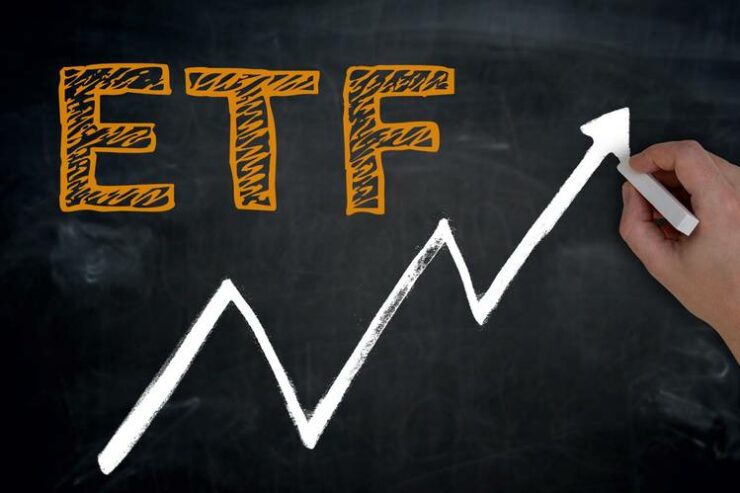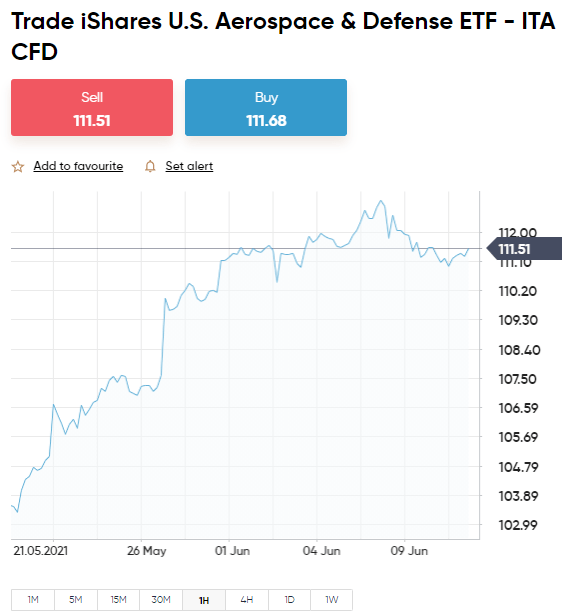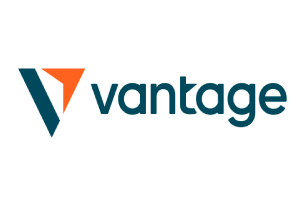ETF Brokers – or simply ‘ETFs’ (Exchange Traded Funds), allow you to invest in an asset, or group of assets, without taking ownership. The overarching benefit of doing this is to gain exposure to markets that would otherwise be difficult to reach as a retail trader.
Our Forex Signals
1 - month
Subscription
 Up to 15 signals daily
Up to 15 signals daily 76% success rate
76% success rate Entry, take profit & stop loss
Entry, take profit & stop loss Amount to risk per trade
Amount to risk per trade Risk reward ratio
Risk reward ratiomonth
3 - month
Subscription
 Up to 15 signals daily
Up to 15 signals daily 76% success rate
76% success rate Entry, take profit & stop loss
Entry, take profit & stop loss Amount to risk per trade
Amount to risk per trade Risk reward ratio
Risk reward ratiomonth
 Most popular
Most popular
6 - month
Subscription
 Up to 15 signals daily
Up to 15 signals daily 76% success rate
76% success rate Entry, take profit & stop loss
Entry, take profit & stop loss Amount to risk per trade
Amount to risk per trade Risk reward ratio
Risk reward ratiomonth
Lifetime
Subscription
 Up to 15 signals daily
Up to 15 signals daily 76% success rate
76% success rate Entry, take profit & stop loss
Entry, take profit & stop loss Amount to risk per trade
Amount to risk per trade Risk reward ratio
Risk reward ratioSeparate Swing Trading Group
 Up to 3 signals weekly
Up to 3 signals weekly 76% success rate
76% success rate Entry, take profit & stop loss
Entry, take profit & stop loss Amount to risk per trade
Amount to risk per trade Risk reward ratio
Risk reward ratiomonth
1 - month
Subscription
 Up to 15 signals daily
Up to 15 signals daily 76% success rate
76% success rate Entry, take profit & stop loss
Entry, take profit & stop loss Amount to risk per trade
Amount to risk per trade Risk reward ratio
Risk reward ratiotime
Think along the lines of foreign government bonds, real estate, or legal marijuana. ETFs are also useful for diversification purposes, as they allow you to invest in multiple assets via a single trade.
Eightcap - Regulated Platform With Tight Spreads

- Minimum deposit of just 250 USD to get lifetime access to all the VIP channels
- Use our Secure and Encrypted Infrastructure
- Spreads from 0.0 pips on Raw Accounts
- Trade on the Award-Winning MT4 & MT5 Platforms
- Multi-jurisdictional Regulation
- No Commission Trading on Standard Accounts

In order to access this multi-billion pound space, you’ll need to find a reliable ETF broker. With hundreds of platforms active in the market, you’ll also need to consider metrics such as regulation, fees, commissions, and payment methods.
In this article, we explore the best ETF brokers in the online space. We also explain the ins and outs of how ETFs actually work, and how you can make an investment today.
Note: If you don’t have any personal experience of investing in ETFs, it might be worth opting for a mutual fund. This will allow you to make gains in the ETF space without needing to have any knowledge of the financial markets.
What are ETFs?
In a nutshell, ETFs allow you to invest in financial instruments without you owning or storing the underlying asset or group of assets. The main concept of ETFs is that they track the real-world prices of assets and thus – they make it super-easy to gain exposure to a particular marketplace. In fact, ETFs have the capacity to track virtually any asset class, as long as a marketplace exists.
For example, let’s take a look at the S&P 500. For those unaware, this is a stock market index that tracks the largest 500 publically-listed companies in the US. Ordinarily, if you wanted to gain exposure to the wider US stock markets, you would be required to purchase 500 individual shares. Not only would this be extremely time-consuming, but you’d pay an extortionate amount in broker commissions.

It is important to note that ETFs are not reserved just for traditional stock markets. On the contrary, there are tens of thousands of ETFs currently in the market that track all sorts of assets. This includes commodities like gold, silver, legal marijuana, oil, and wheat, domestic and foreign real estate, and specific sectors like manufacturing, air travel, and finance.
Pros and Cons of ETFs
The Pros
- Access thousands of markets at the click of a button.
- Invest in a group of assets via a single trade.
- Track virtually any asset class that has a market.
- Gain exposure to markets that would other be difficult to reach.
- Fees are super-low.
- Ability to short an asset with ease.
- Hundreds of ETF brokers to choose from.
The Cons
- You do not own the underlying asset
- You will need to choose your own investments
What are ETF Brokers?
If you like the sound of ETFs, you’ll need to find an ETF broker. In the vast majority of cases, these are traditional online brokers that offer a wealth of asset classes – such as stocks, bonds, mutual funds, and of course – ETFs. As such, the investment process works largely the same as any other brokerage firm.
For example, you will need to find a broker that meets your needs and then open an account. Upon verifying your identity, you will then need to deposit funds. Once your account has been set up, you will then need to choose an ETF to invest in. Crucially, unless you have entrusted your money with a mutual fund, you will need to invest on a DIY basis.
How Do ETFs Work?
ETF brokers make the investment process super easy. With that said, if you’ve never invested in an ETF, it is important that you do some research before parting with your money.
Check out the fundamentals below.
✔️ Physical ETFs vs CFDs
If you are investing in a physical ETF, this means that the broker will actually invest in the asset. For example, let’s say that you invest in an ETF that tracks the Dow Jones Index. In doing so, the ETF broker would purchase stocks in the 30 companies that represent the Dow.
Moreover, the ETF broker will weigh their purchases so that it mirrors the index like-for-like. For example, if Walt Disney makes up 5% of the Dow Jones in terms of weighting, then the ETF broker’s portfolio will contain 5% of Walt Disney shares.
Alternatively, you might decide to invest with a CFD broker that gives you access to ETFs. In doing so, the CFD broker will track the real-world price of an ETF market, but not purchase the underlying assets.
From the respective of an investor, CFDs work much in the same way as investing with a physical ETF provider, albeit, you’ll often find that fees and commissions are much lower.
✔️ Long vs Short
An additional benefit of investing in ETFs is that you will have the option of going long or short on your chosen marketplace. For those unaware, going long means that you are investing in the asset going up in value.
In the case of going short, you are speculating that the price of ETF will decline. While all ETF brokers allow you to go long on a market, you will need to use a CFD broker if you wish to go short.
- If you want to go long on an ETF, you will need to place a ‘buy’ order
- If you want to short-sell an ETF, you will need to place a ‘sell’ order.
✔️ ETF Markets
When it comes to selecting an ETF to invest in, you will have tens of thousands of markets to choose from. With that said, there are some standout assets that ETFs track and thus – most ETF brokers will give you access to.
We’ve listed the most commonly traded ETF markets below.
- Stock Markets: As noted above, ETFs allow you to invest in the wider stock markets. For example, if you wanted to gain exposure to the US economy, you could invest in an ETF that tracks the S&P 500 or Dow Jones. If you want to stick with UK markets, you could invest in the FTSE 100.
- Bonds: ETFs are a great way to gain access to bond markets that would otherwise be difficult to reach. At the forefront of this is foreign government bonds that only sell in minimum lot sizes of 6 or 7 figures.
- Real Estate: Some ETF brokers will offer Real Estate Investment Trusts (REITs) that seek to track a particular property market. This allows you to invest in real estate without needing to purchase a home outright -both domestically and abroad.
- Legal Marijuana: The legal marijuana space is already a multi-billion pound industry. As such, it was only a matter of time before a marijuana ETF came to fruition. In fact, there are a few ETFs to choose from, most of which track marijuana growers and suppliers.
- Interest Rates: You can also invest in an ETF that tracks interest rate prices. This is a great way to tie your investment to a specific currency.
- Commodities: If you want to gain exposure to a commodity like gold, oil, natural gas, or wheat, ETFs allow you to do this with ease. Once again, there is no requirement to own or store the underlying asset, so you can also short the commodity.
The above list is not exhaustive. In fact, there are many other markets that ETF brokers allow you to track.
How do I Make Money When Invested in ETFs?
In the vast majority of cases, you will make money from an ETF investment through capital gains. As we will cover shortly, some ETFs also allow you to earn your share of dividend payments if it tracks real-world stocks.
Nevertheless, let’s look a couple of examples of how you would make money when going long and short on an ETF.
🥇 Going Long on an FTSE 100 ETF
Let’s say that you want to invest in the 100 companies that make up the FTSE 100. You are feeling positive about the UK economy, so you decide to go long.
- The FTSE 100 is currently priced at 3,000 points
- You invest £1,000 into the ETF with an online broker
- As such, you place a ‘buy’ order
- A few months later, the FTSE 100 is now priced at 3,600 points
- This amounts to an increase of 20%
- You cash out your investment with your chosen online broker
- As you cashed out £1,200, you made £200 in gains
🥇 Going Short on a Turkey Government Bond ETF
You think that the Turkish economy is set for thought time over the coming months. As such, you decide to gain exposure to the market by investing in an ETF that tracks the yield on Turkey’s government bonds.
- 10-year Turkey government bonds currently have a yield of 7%
- You invest £1,000 into the ETF with an online broker
- As you are bearish on the Turkish economy, you place a ‘sell’ order
- A few months later, the central bank of Turkey announces that it is cutting interest rates to help boost the economy
- This means that its 10-year bonds go down in value, so the yield increases to 9%
- As you shorted the market, you are now in profit by just over 28% (yield increase from 7% to 9%)
- You decide to cash out your gains, so you place a ‘buy’ order
- At gains of 28% on a £1,000 stake, you made £280 in profit
Do ETFs pay Dividends?
In some cases, ETFs allow you to earn your share of dividend payments, if applicable. For example, let’s say that the ETF tracks the FTSE 100. If 85 of those companies pay quarterly dividends, you will receive your share – proportionate to the amount that you invest.
However, you will only qualify for these dividends if the ETF provider physically holds the underlying shares within its portfolio. This won’t be the case if you are using a CFD broker to invest in an FTSE 100 ETF, and the broker merely tracks the price of the respective ETF.
Note: If you are entitled to dividends, the ETF provider will likely payout on a quarterly basis. This is because they will likely receive dividend payments on a day-to-day basis, as companies payout on different dates.
How do I Choose an ETF Broker?
So now that you know how ETFs work, you now need to think about which provider you wish to use. In this sense, you’ve got three options:
- Go direct with the financial institution that owns the ETF (for example Vanguard)
- Use an online broker that gives you access to ETFs
- Use a CFD broker
With that being said, there are heaps of other metrics that you need to consider before joining a new ETF broker. As such, be sure to read through the following tips.

✔️ Regulation
Without a doubt, the most important consideration that you need to make is with regard to regulation. Crucially, you should only use a broker that holds at least one license from a tier-one regulator.
This should include the likes of the UK’s FCA, ASIC (Australia), MAS (Singapore), or CySEC (Cyprus). If the broker isn’t regulated, or it only holds a license from a non-tier-one jurisdiction (like the British Virgin Islands), you should avoid it at all costs.
✔️ Tradable ETFs
You then need to spend some time exploring the broker’s ETF department. After all, you need to ensure that the broker supports the specific ETF that you wish to invest in. For example, if you’re looking to invest in a stock market ETF, we would expect to see the FTSE 100, NASDAQ 100, Dow Jones, and more.
You also need to assess whether you want the option of going short to apply leverage. If you’re planning to do either of these, you will need to opt for a CFD broker that supports ETFs instruments.
✔️ Deposits and Withdrawals
If you’re looking to invest with an ETF, you will be risking your own money. As such, you need to explore what payment methods are supported. Most ETF brokers allow you to deposit funds with a debit or credit card, as well as a bank wire.
Some ETF brokers also facilitate e-wallet payments. If they do, this will include the likes of PayPal, Skrill, and Neteller. On top of the specific payment options supported, you also need to check the minimum deposit amounts.
Moreover, check to see if the ETF broker charges any deposit or withdrawal fees – especially if you’re planning to use a credit card.
✔️ Eligibility
Some ETF brokers are restricted in the countries that they can serve. For example, if you’re based in the UK, the broker will usually need to hold a license with the FCA – or a European based regulator like CySEC.
✔️ Fees and Commissions
ETF brokers will always charge a fee. At the forefront of this is an annual maintenance fee. As the name suggests, you will need to pay a fee on your ETF investment for as long as it remains open. For example, let’s say that you invest £5,000 into a REIT ETF, and the broker charges an annual fee of 1.5%.
This means that you would pay £75 per year on your ETF investment. In other words, you would need to make at least 1.5% in gains just to break even. As such, stick with ETF brokers that offer super-low maintenance fees.
✔️ Educational Resources
If you’re still in the newbie in the world of ETFs, you’ll want to choose a broker that offers heaps of educational resources. Not only should this include video explains and step-by-step trading guides, but also real-time news analysis.
After all, you will be required to choose your investments on a DIY basis, so you’ll need all the help you can get.
✔️ Customer Support
Although ETF brokers cannot give you advice on what investments you should make, they can help you when it comes to setting up a trade. As such, you should opt for a broker that offers top-notch customer service.
This should include a choice of live chat, email, and telephone support – preferably 24 hours per day.
How do I Invest With an Online ETF Broker?
So now that you know what you need to look out for when choosing an ETF broker, we are now going to show you how you can get started. Simply follow the step-by-step guidelines outlined below to get your ETF investment journey underway.
Step 1: Choose an ETF Broker
Your first port of call will be to choose an ETF broker that meets your needs. If you’re looking to research a broker yourself, simply review the tips outlined in the section above. Crucially, you need to assess whether you want to opt for a CFD broker (if short-selling and applying leverage) or a traditional ETF broker (if looking to earn dividends).
If you don’t have time to research a platform yourself, we would suggest reviewing the five ETF brokers listed further down on this page. All of our top-picks meet our strict set of requirements – especially those surrounding regulation, low fees, and payment methods.
Step 2: Open an Account
You will now need to open an account with your chosen ETF broker. This is to ensure that the platform remains compliant with its licensing body, as well as the laws concerning anti-money laundering.
As such, you’ll need to provide the following information:
- Full Name.
- Nationality.
- Home Address.
- Date of Birth.
- National Insurance Number (or Tax Identification Number).
- Contact Details.
The broker will then attempt to verify your information electronically. If it is unable to do so, you’ll be asked to upload a copy of your passport or driver’s license.
Step 3: Deposit Funds
Once your ETF brokerage account has been set up, you will then be asked to deposit some funds. The specific payment methods available from you will vary from broker-to-broker.
With that said, most allow you to deposit with a bank transfer or debit/credit card. If you’re looking to use an e-wallet like PayPal, you’ll likely need to use a CFD broker.
Step 4: Locate Your Preferred ETF
It’s very rare to find a broker that specializes exclusively in ETFs, so the platform you are using is like to offer a range of other asset classes, too. As such, you’ll need to head over to the ETF section of the site.

Step 5: Make an Investment
Once you’ve located the ETF that you wish to invest in, you will then need to decide whether you want to go long (buy order) or short (sell order). Don’t forget, you can only go short if you are using a CFD broker.
Next, you then need to decide how much you wish to invest. Enter this into the respective box, alongside your preferred entry price. If you’re happy to take the next available price, opt for a market order.
If investing in an ETF via a CFD product, this is where you will get to apply leverage. The amount you can apply will be determined by the broker, the asset you are trading, and your location.
Finally, place your buy/sell order to complete your ETF investment.
Step 6: Cashing Out Your ETF Investment
ETF investments remain in play for as long as you wish. This is even the case if investing in finite asset classes like bonds. As such, the value of your ETF investment will go up and down as per the asset it is tracking. You will have the option of cashing your investment out at any given time – hopefully at a profit.
When you do cash it out, the funds will instantly be placed into your ETF brokerage cash account. You can then invest in other assets or simply request a withdrawal back to your bank account.
Best 2 ETF Brokers: Our Top Broker Picks of 2023
With hundreds of ETF brokers to choose from, it can be a time-consuming process to find a platform that meets your long-term needs. Crucially, if you’re looking for a regulated broker that offers heaps of ETF markets, low fees, competitive spreads, and lots of everyday payment methods – we would suggest exploring the following five brokers.
1. AVATrade – 2 x $200 Forex Welcome Bonuses
The team at AVATrade are now offering a huge 20% forex bonus of up to $10,000. This means that you will need to deposit $50,000 to get the maximum bonus allocation. Take note, you'll need to deposit a minimum of $100 to get the bonus, and your account needs to be verified before the funds are credited. In terms of withdrawing the bonus out, you'll get $1 for every 0.1 lot that you trade.

- 20% welcome bonus of upto $10,000
- Minimum deposit $100
- Verify your account before the bonus is credited
2. VantageFX – Ultra-Low Spreads
VantageFX VFSC under Section 4 of the Financial Dealers Licensing Act that offers heaps of financial instruments. All in the form of CFDs - this covers shares, indices, and commodities.
Open and trade on a Vantage RAW ECN account to get some of the lowest spreads in the business. Trade on institutional-grade liquidity that is obtained directly from some of the top institutions in the world without any markup being added at our end. No longer the exclusive province of hedge funds, everyone now has access to this liquidity and tight spreads for as little as $0.
Some of the lowest spreads in the market may be found if you decide to open and trade on a Vantage RAW ECN account. Trade using institutional-grade liquidity that is sourced directly from some of the top institutions in the world with zero markup added. This level of liquidity and availability of thin spreads down to zero are no longer the exclusive purview of hedge funds.

- The Lowest Trading Costs
- Minimum deposit $50
- Leverage up to 500:1
Conclusion
In summary, you should now have a good idea of how ETFs work in practice. This includes the underlying make-up of ETFs, the many markets that you can invest in, and the mechanisms required to engage in short-selling. The most important takeaway is that you choose an ETF broker that best meets your long-term trading requirements.
At a minimum, this should be a broker with a strong regulatory standing, competitive fees, and support for heaps of payment methods. If you don’t have time to research a platform yourself, we have also listed our five recommended ETF brokers of 2023 – each of which meets our strict criteria.
AvaTrade - Established Broker With Commission-Free Trades

- Minimum deposit of just 250 USD to get lifetime access to all the VIP channels
- Awarded Best Global MT4 Forex Broker
- Pay 0% on all CFD instruments
- Thousands of CFD assets to trade
- Leverage facilities available
- Instantly deposit funds with a debit/credit card

FAQs
What is an ETF broker?
What is the minimum deposit do ETF brokers ask for?
Do ETFs pay dividends?
Are ETF brokers regulated?
Can you short an ETF?
How do physical ETFs make money?
What payment methods do ETF brokers support?